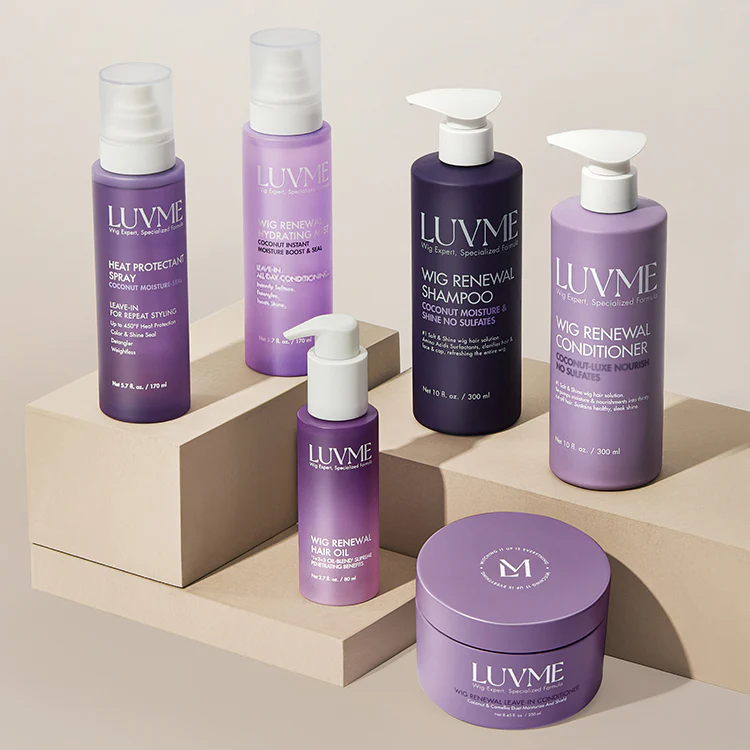Effective Tips for Long-Lasting Glueless HD Lace Wigs

Maintaining the best glueless HD lace wigs ensures longevity and a natural appearance. These wigs offer versatility and ease of use, making them a popular choice. Proper care can extend the lifespan of these wigs up to one year or more. The following practical tips will help achieve the best results for long-lasting wear.
Choosing the Right Glueless HD Lace Wig

Understanding Different Types of Lace
Swiss Lace vs. French Lace
Swiss lace offers a delicate and lightweight option. This type of lace provides a more natural look. The material is softer and blends seamlessly with the scalp. French lace, on the other hand, is thicker and more durable. This lace type suits those who prioritize longevity over subtlety. Both options have their unique advantages.
Benefits of HD Lace
HD lace stands out for its ultra-thin and transparent qualities. This lace type creates an undetectable hairline. The material adapts to various skin tones, enhancing the wig's natural appearance. HD lace also offers superior comfort due to its lightweight nature. Users can enjoy a flawless look without compromising on comfort.
Selecting the Right Wig Cap Size
Measuring Your Head
Accurate head measurements ensure a perfect fit. Use a flexible tape measure for this task. Measure the circumference of the head, starting at the front hairline. Continue around the head, passing just above the ears and nape of the neck. Record the measurement to find the appropriate wig cap size.
Importance of a Proper Fit
A well-fitted wig cap enhances comfort and security. An ill-fitting cap can cause discomfort and slippage. Proper fit ensures the wig stays in place throughout the day. This stability allows for a more natural and confident appearance. Always refer to the manufacturer's sizing guide for best results.
Quality of Hair Used
Human Hair vs. Synthetic Hair
Human hair wigs offer unmatched realism and versatility. These wigs can be styled, dyed, and treated like natural hair. Synthetic hair wigs, while more affordable, lack this flexibility. They often have a shorter lifespan and can appear less natural. For those seeking long-term use, human hair wigs are the superior choice.
Remy Hair Benefits
Remy hair represents the highest quality of human hair wigs. The cuticles remain intact and aligned in one direction. This alignment reduces tangling and increases longevity. Remy hair wigs provide a smooth and natural look. Investing in Remy hair ensures a premium and durable wig experience.
Proper Application Techniques
Preparing Your Natural Hair
Braiding or Wrapping Techniques
Braiding natural hair provides a flat base for the wig. This technique minimizes bulk and creates a smooth surface. Small, tight braids work best for this purpose. Wrapping hair also serves as an effective method. Use a silk or satin scarf to wrap the hair. This approach reduces friction and protects the hair.
Using a Wig Cap
A wig cap offers additional benefits. It secures the natural hair and prevents movement. The cap also creates a barrier between the wig and scalp. This barrier helps in maintaining hygiene and comfort. Choose a breathable and lightweight cap for optimal results.
Applying the Wig
Aligning the Lace
Proper alignment of the lace ensures a natural look. Start by placing the wig on the head. Adjust the lace to match the natural hairline. Use a mirror for accuracy. Ensure that the lace lies flat against the scalp. This step is crucial for achieving an undetectable hairline.
Securing Without Glue
Securing the wig without glue involves several steps. Use adjustable straps located inside the wig cap. Tighten these straps for a snug fit. Clips and combs attached to the wig provide extra security. Insert these combs into the natural hair. This method keeps the wig in place throughout the day.
Styling Tips
Heat Styling Precautions
Heat styling can damage the wig if not done correctly. Use heat tools with adjustable temperature settings. Set the tools to a low or medium heat level. Always apply a heat protectant spray before styling. This precaution minimizes the risk of damage.
Using Wig-Friendly Products
Wig-friendly products enhance the longevity of the wig. Choose shampoos and conditioners specifically designed for wigs. Avoid products containing sulfates and alcohol. These ingredients can dry out the hair and lace. Opt for lightweight styling products to maintain the wig's natural appearance.
Maintenance and Care

Daily Care Routine
Brushing and Detangling
Regular brushing keeps the wig looking fresh and prevents tangles. Use a wide-tooth comb or a wig brush designed for delicate fibers. Start from the ends and work upwards to avoid breakage. Always brush gently to maintain the integrity of the hair and lace.
Avoiding Friction
Friction can cause wear and tear on the wig. Sleep on a silk or satin pillowcase to reduce friction. Avoid wearing hats or tight headbands that can rub against the wig. This practice helps in preserving the wig's natural appearance and longevity.
Washing and Conditioning
Recommended Products
Choose products specifically formulated for wigs. Sulfate-free shampoos and conditioners work best. These products clean without stripping essential moisture. Leave-in conditioners provide continuous hydration. Expert recommendations highlight the importance of conditioning to maintain softness and manageability.
Washing Frequency
Wash the wig every 10-15 wears or when product buildup becomes noticeable. Fill a basin with cool water and add a small amount of wig shampoo. Gently swish the wig in the water without rubbing. Rinse thoroughly and apply conditioner. Let the conditioner sit for a few minutes before rinsing again. Pat dry with a towel and air dry on a wig stand.
Storage Tips
Using a Wig Stand
A wig stand helps maintain the shape and structure of the wig. Place the wig on the stand when not in use. This practice prevents tangling and keeps the wig looking its best. A mannequin head also serves as a good alternative for storage.
Protecting from Dust and Sunlight
Store the wig in a cool, dry place away from direct sunlight. Sunlight can fade the color and weaken the fibers. Use a breathable cover to protect the wig from dust. Avoid storing the wig in plastic bags, as they can trap moisture and cause damage.
Troubleshooting Common Issues
Shedding and Tangling
Preventive Measures
Shedding and tangling can significantly reduce the lifespan of a glueless HD lace wig. To prevent these issues, start by using high-quality hair care products. Opt for sulfate-free shampoos and conditioners designed specifically for wigs. These products maintain the integrity of the hair fibers and lace foundation.
Regular brushing helps minimize tangles. Use a wide-tooth comb or a wig brush, starting from the ends and working upwards. This method reduces breakage and maintains a smooth appearance. Avoid excessive heat styling, as it can weaken the hair strands and cause shedding. Always apply a heat protectant spray before using any heat tools.
Solutions for Existing Problems
When tangling occurs, gently detangle the wig using a wide-tooth comb. Start from the ends and work your way up to the roots. For severe tangles, use a wig detangling spray to ease the process. Avoid pulling or tugging, as this can cause further damage.
For shedding, inspect the wig for loose hairs. Apply a small amount of wig-friendly serum to the affected areas. This treatment helps strengthen the hair fibers and reduces further shedding. If shedding persists, consider consulting a professional for advice on potential repairs or adjustments.
Lace Damage
Repair Techniques
Lace damage can compromise the natural appearance of a glueless HD lace wig. Small tears or holes in the lace can be repaired using a needle and thread. Choose a thread color that matches the lace for a seamless repair. Carefully stitch the damaged area, ensuring the stitches are tight but not too tight to avoid further tearing.
For larger areas of damage, lace patches offer an effective solution. Cut a piece of lace slightly larger than the damaged area. Place the patch over the tear and sew it in place using a matching thread. This technique reinforces the damaged lace and extends the wig's lifespan.
When to Replace the Lace
In some cases, lace damage may be beyond repair. Extensive tearing or fraying can affect the overall look and fit of the wig. When repairs no longer provide a satisfactory result, consider replacing the lace. Consult a professional wig maker or stylist for guidance on lace replacement options.
Replacing the lace involves removing the old lace and sewing a new piece onto the wig. This process requires precision and expertise to ensure a natural and secure fit. Investing in lace replacement can rejuvenate the wig and restore its original beauty.
By following these troubleshooting tips, users can address common issues and maintain the longevity and appearance of their glueless HD lace wigs. Proper care and timely repairs ensure a flawless and natural look, enhancing confidence and style.
Maintaining glueless HD lace wigs requires dedication and proper techniques. Regular brushing, gentle handling, and using wig-friendly products ensure longevity. Proper storage and periodic cleaning also play crucial roles. Following these best practices will extend the lifespan of the best glueless HD lace wigs. Investing time in care routines enhances the natural appearance and durability of the wigs. Proper wig care offers significant benefits, including a flawless look and long-term use.






















